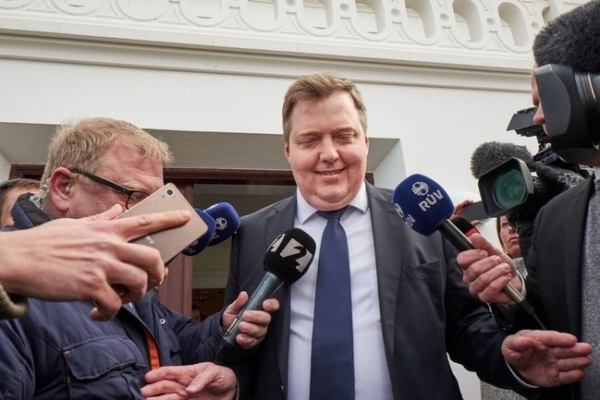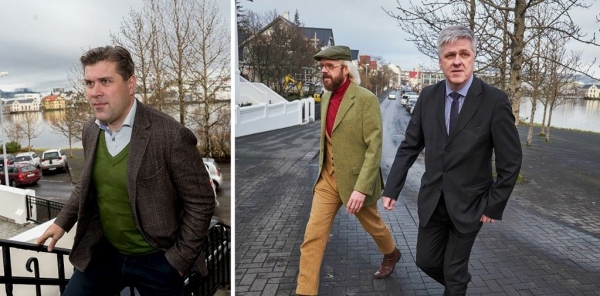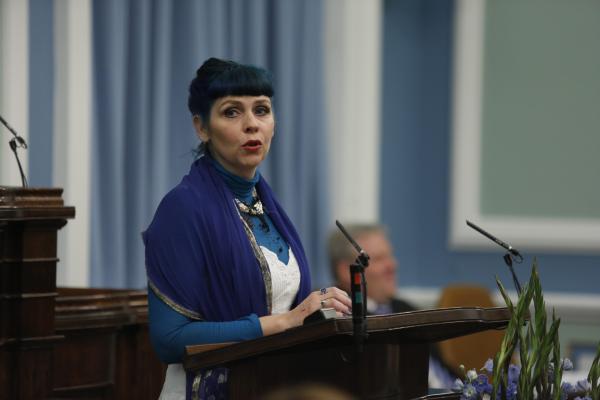On October 29 parliamentary elections were held in Iceland, as voters selected the 63 members who will sit in parliament for the next four years. The early elections, which were called after mass protests over the revelations that the Prime Minister of Iceland, Sigmundur Davíð Gunnlaugsson, had hid significant assets in a tax haven, delivered a rebuke to the center-right government. The Progress party, led by Sigmundur Davíð lost more than half of its MPs. Although the conservative Independence party added 2 MPs the government had lost its majority.

Forming a new government, however, has been difficult. Now, more than a month after the elections were held, there is no solution in sight.
We at Iceland Insider decided to compile a simple guide to what's going on, who the main actors are and why it has proved difficult to form a workable coalition government.
The results of the October 29 elections
The conservative Independence party and the center-right Progress party lost 9 MPs. The Progress party suffered a humiliating defeat, receiving nearly 13 percentage less than it had received in the 2013 elections
| Party | % 2016 | +/- | MPs | +/- |
| Independence party (conservative) | 29% | +2.3% | 21 | +2 |
| Left-green movement (leftist) | 15.9% | +5.2% | 10 | +3 |
| Pirate party (center-left) | 14.5% | +9.4% | 10 | +7 |
| Progress party (center-right/liberal) | 11.5% | -12.9% | 8 | -11 |
| Restoration (center-right/conservative) | 10.5% | +10.5% | 7 | +7 |
| Bright future (centrist) | 7.2% | -1% | 4 | -2 |
| Social democratic alliance (leftist) | 5.7% | -7.2% | 3 | -6 |
Timeline:
- October 29: Elections, the sitting coalition admits defeat
- November 2: President of Iceland, Guðni Th. Jóhannesson hands Bjarni Benediktsson, the chairman of the conservative Independence party a mandate to form new coalition government.
- November 15: Bjarni returns the mandate and admits he has failed to find any parties willing to bolster the parliamentary strength of the sitting coalition or to form a center-right coalition with Restoration and Bright future. Attempts by Bjarni to convince the Left-greens to join in some sort of across-the-aisle coalition have also failed
- November 16: The President hands the mandate to form a government to Katrín Jakobsdóttir, the chairwoman of the Left-green movement.
- November 25: Katrín returns the mandate after attempts to form a five party center-left coalition with Restoration, Bright future, the Pirate party and the Social democratic alliance fail.
- November 25: The President announces he will not hand the mandate to a third party leader, urging the parties to engage in informal discussions to find common ground.
- November 29: Katrín and Bjarni begin informal discussions on an across-the-aisle coalition.
- November 30: The President announces that Parliament will be called into session on December 6 whether or not a new government has been formed.
- December 1: The four parties of the center and left begin informal talks, without the Left greens.
Why have attempts to form a new coalition failed?
With 63 members of parliament a majority coalition would have to count at least 32 MPs. The situation is made more complex by the following:

Fractured parties and blocks
The centrist parties have promised to enter into any coalition government as a block 11 MPs strong, effectively reducing the number of players to six. The Progressive party remains deeply fractured and highly toxic after the Panama papers scandal which forced its former chairman and Prime Minister of Iceland, Sigmundur Davíð Gunnlaugsson, to resign.
Only the Independence party remains strongly supportive of working with the Progressive party. Sigmundur and the current chairman have not seen eye-to-eye, and most pundits believe the party will not operate as a cohesive unit, reducing its size in parliament to 6 or 7.

Center-right coalition?
Restoration and Bright future have ruled out a government where both the Independence party and Progress party (the previous coalition parties) are represented. The Independence party + Restoration + Bright future only have 32 MPs
Many in the Independence party distrust Restoration, which is largely made up of former members of the Independence party who split over the growing conservativism of the Independence party. A 1 MP majority would make such a government very unstable.
The main policy disagreements are over changes to agricultural and fisheries policies, application for membership in the European Union and changes to the Icelandic constitution.

A center-left coalition?
The Pirate party has refused to work with the Progress party, making a five party coalition of Left-greens, Restoration, Bright future, Social democratic alliance and Pirate party the only option for a center-left coalition. There are no obvious reasons why compromise could not be found to form such a government.
However, significant policy disagreement exists between the five parties. Restoration has opposed tax hikes favoured by the Left-greens, while the Left-greens and the two centrist parties disagree on the nature of reforms to the fisheries and agricultural policies. The left greens favour an approach focused on taxes and command and control measures, while the centrist parties, as well as the Pirates, favour market based solutions.

Across the aisle coalitions?
The Left-greens have repeatedly refused to contemplate working with the Conservative party, and the party grassroots would be a permanent source of internal opposition to the government.
The Pirate party has ruled out joining a government with either the Independence or Progress parties. The Left green movement has stressed that the Social democratic alliance would have to join such a coalition. The Social democrats, who suffered a humiliating loss in the October 29 elections, have been hesitant to risk working with a far more powerful Left green movement and the conservatives.
Policy disagreements in such a government would be enormous, but many pundits believe the compromises struck could lay the ground for solid political and economic stability.
Minority government?
The fourth option is a minority government enjoying the neutrality of either some of the centrist parties or the Pirate party.
The Pirate party has repeatedly said it is willing to support a minority government. Such a government would in all likelihood not sit a full four year term, but would instead focus on making some previously agreed upon changes to the constitution or the agricultural and fishing systems.
On October 29 parliamentary elections were held in Iceland, as voters selected the 63 members who will sit in parliament for the next four years. The early elections, which were called after mass protests over the revelations that the Prime Minister of Iceland, Sigmundur Davíð Gunnlaugsson, had hid significant assets in a tax haven, delivered a rebuke to the center-right government. The Progress party, led by Sigmundur Davíð lost more than half of its MPs. Although the conservative Independence party added 2 MPs the government had lost its majority.

Forming a new government, however, has been difficult. Now, more than a month after the elections were held, there is no solution in sight.
We at Iceland Insider decided to compile a simple guide to what's going on, who the main actors are and why it has proved difficult to form a workable coalition government.
The results of the October 29 elections
The conservative Independence party and the center-right Progress party lost 9 MPs. The Progress party suffered a humiliating defeat, receiving nearly 13 percentage less than it had received in the 2013 elections
| Party | % 2016 | +/- | MPs | +/- |
| Independence party (conservative) | 29% | +2.3% | 21 | +2 |
| Left-green movement (leftist) | 15.9% | +5.2% | 10 | +3 |
| Pirate party (center-left) | 14.5% | +9.4% | 10 | +7 |
| Progress party (center-right/liberal) | 11.5% | -12.9% | 8 | -11 |
| Restoration (center-right/conservative) | 10.5% | +10.5% | 7 | +7 |
| Bright future (centrist) | 7.2% | -1% | 4 | -2 |
| Social democratic alliance (leftist) | 5.7% | -7.2% | 3 | -6 |
Timeline:
- October 29: Elections, the sitting coalition admits defeat
- November 2: President of Iceland, Guðni Th. Jóhannesson hands Bjarni Benediktsson, the chairman of the conservative Independence party a mandate to form new coalition government.
- November 15: Bjarni returns the mandate and admits he has failed to find any parties willing to bolster the parliamentary strength of the sitting coalition or to form a center-right coalition with Restoration and Bright future. Attempts by Bjarni to convince the Left-greens to join in some sort of across-the-aisle coalition have also failed
- November 16: The President hands the mandate to form a government to Katrín Jakobsdóttir, the chairwoman of the Left-green movement.
- November 25: Katrín returns the mandate after attempts to form a five party center-left coalition with Restoration, Bright future, the Pirate party and the Social democratic alliance fail.
- November 25: The President announces he will not hand the mandate to a third party leader, urging the parties to engage in informal discussions to find common ground.
- November 29: Katrín and Bjarni begin informal discussions on an across-the-aisle coalition.
- November 30: The President announces that Parliament will be called into session on December 6 whether or not a new government has been formed.
- December 1: The four parties of the center and left begin informal talks, without the Left greens.
Why have attempts to form a new coalition failed?
With 63 members of parliament a majority coalition would have to count at least 32 MPs. The situation is made more complex by the following:

Fractured parties and blocks
The centrist parties have promised to enter into any coalition government as a block 11 MPs strong, effectively reducing the number of players to six. The Progressive party remains deeply fractured and highly toxic after the Panama papers scandal which forced its former chairman and Prime Minister of Iceland, Sigmundur Davíð Gunnlaugsson, to resign.
Only the Independence party remains strongly supportive of working with the Progressive party. Sigmundur and the current chairman have not seen eye-to-eye, and most pundits believe the party will not operate as a cohesive unit, reducing its size in parliament to 6 or 7.

Center-right coalition?
Restoration and Bright future have ruled out a government where both the Independence party and Progress party (the previous coalition parties) are represented. The Independence party + Restoration + Bright future only have 32 MPs
Many in the Independence party distrust Restoration, which is largely made up of former members of the Independence party who split over the growing conservativism of the Independence party. A 1 MP majority would make such a government very unstable.
The main policy disagreements are over changes to agricultural and fisheries policies, application for membership in the European Union and changes to the Icelandic constitution.

A center-left coalition?
The Pirate party has refused to work with the Progress party, making a five party coalition of Left-greens, Restoration, Bright future, Social democratic alliance and Pirate party the only option for a center-left coalition. There are no obvious reasons why compromise could not be found to form such a government.
However, significant policy disagreement exists between the five parties. Restoration has opposed tax hikes favoured by the Left-greens, while the Left-greens and the two centrist parties disagree on the nature of reforms to the fisheries and agricultural policies. The left greens favour an approach focused on taxes and command and control measures, while the centrist parties, as well as the Pirates, favour market based solutions.

Across the aisle coalitions?
The Left-greens have repeatedly refused to contemplate working with the Conservative party, and the party grassroots would be a permanent source of internal opposition to the government.
The Pirate party has ruled out joining a government with either the Independence or Progress parties. The Left green movement has stressed that the Social democratic alliance would have to join such a coalition. The Social democrats, who suffered a humiliating loss in the October 29 elections, have been hesitant to risk working with a far more powerful Left green movement and the conservatives.
Policy disagreements in such a government would be enormous, but many pundits believe the compromises struck could lay the ground for solid political and economic stability.
Minority government?
The fourth option is a minority government enjoying the neutrality of either some of the centrist parties or the Pirate party.
The Pirate party has repeatedly said it is willing to support a minority government. Such a government would in all likelihood not sit a full four year term, but would instead focus on making some previously agreed upon changes to the constitution or the agricultural and fishing systems.







